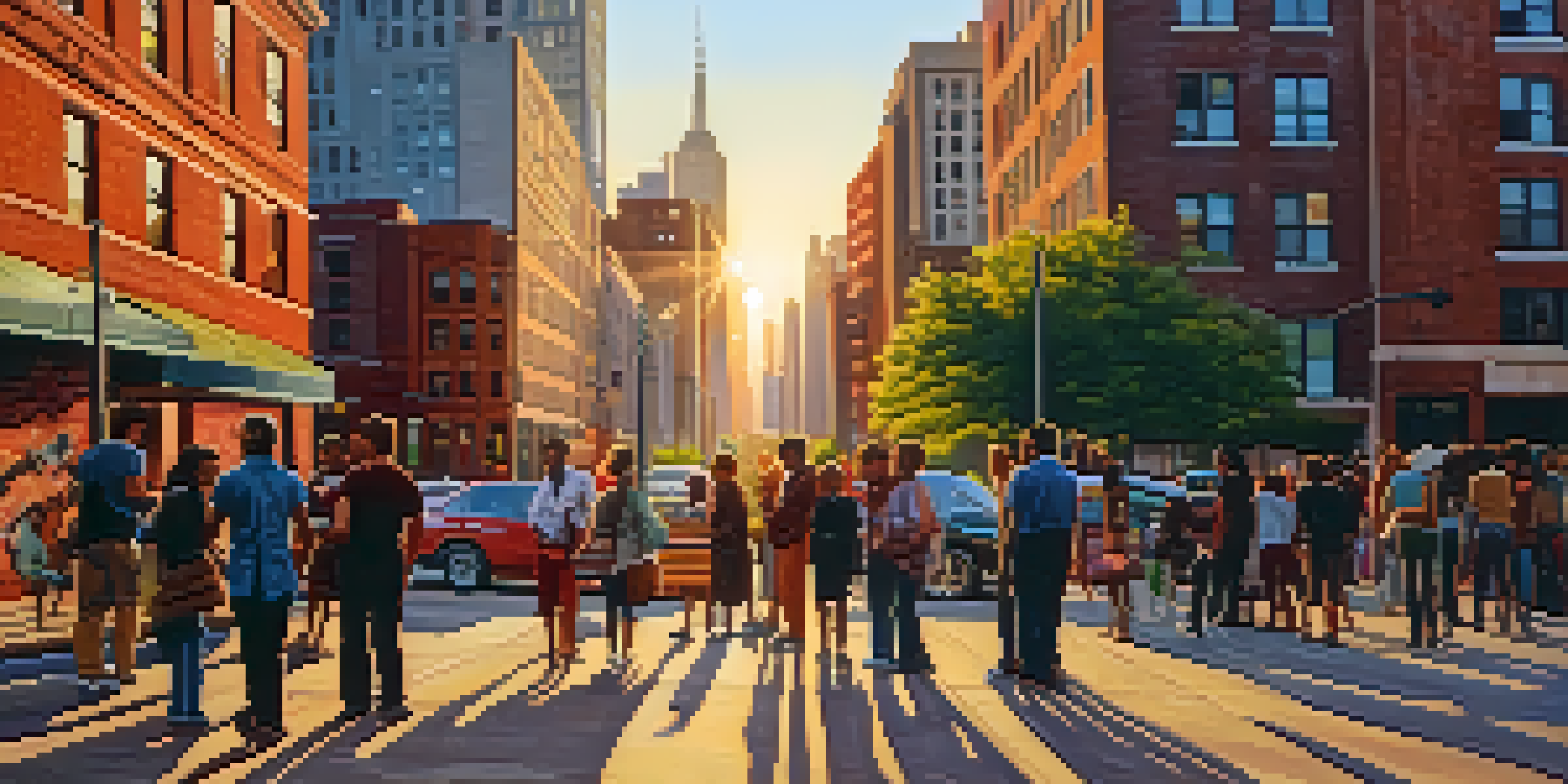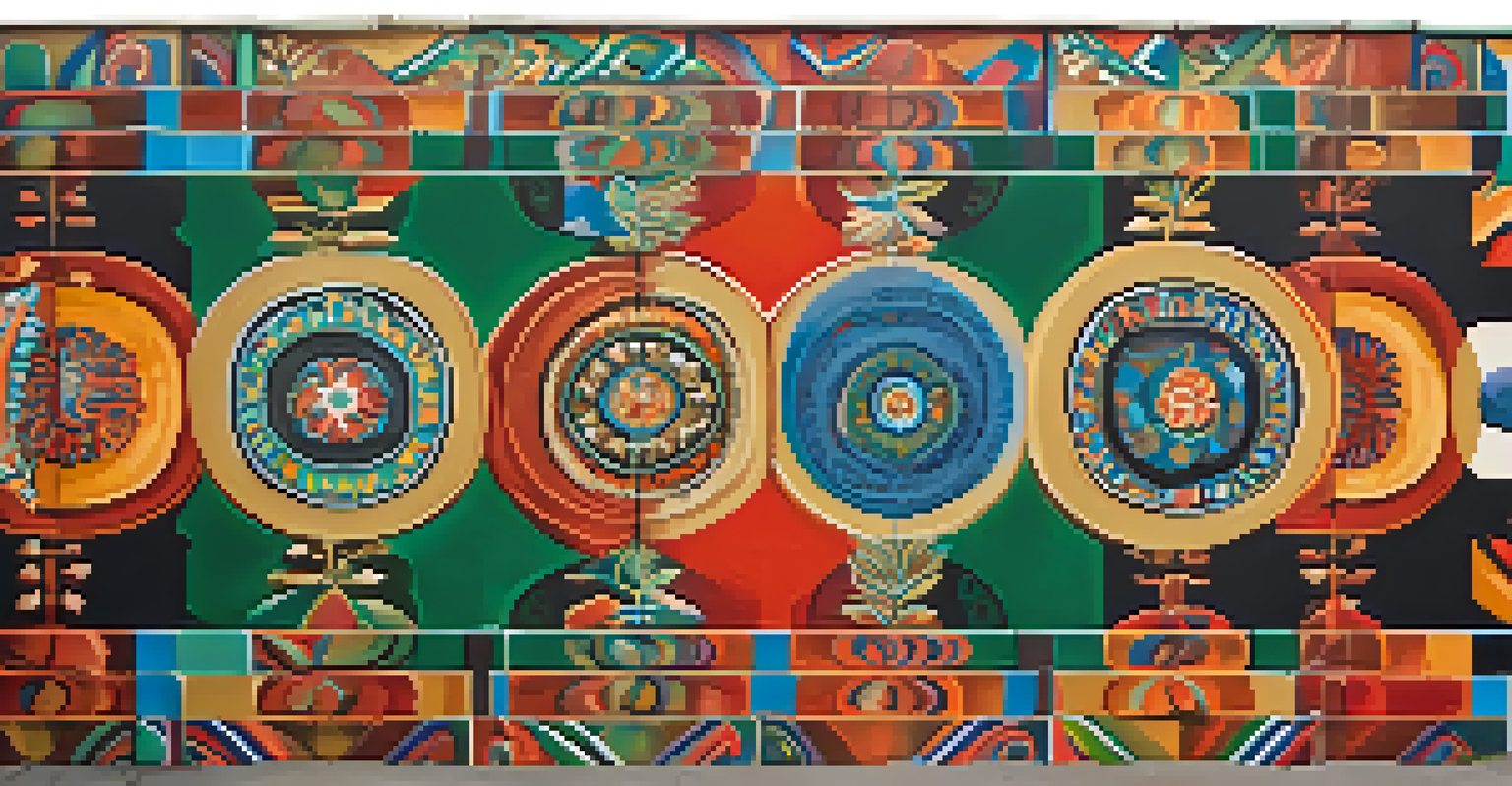Exploring the Aesthetics of Urban Spaces in Modern Art

The Intersection of Art and Urban Landscapes
Urban environments serve as a vibrant backdrop for modern art, reflecting the complexities of city life. Artists are drawn to the dynamic interplay between architecture, nature, and human activity, creating a visual narrative that resonates with viewers. This fusion of elements not only highlights the aesthetics of urban spaces but also invites deeper contemplation about our relationship with these environments.
Art is not a mirror to hold up to society, but a hammer with which to shape it.
For instance, the works of artists like Banksy and Keith Haring exemplify how urban spaces can be transformed into canvases for expression. Their art engages with the public in unexpected places, turning mundane streets into vibrant galleries. This approach not only beautifies the surroundings but also provokes thought on social issues and urban identity.
Moreover, the use of urban landscapes in modern art challenges traditional notions of beauty, encouraging artists to explore themes of decay, gentrification, and community. By doing so, they create a dialogue that reflects the ever-evolving nature of cities and the stories within them.
Elements of Urban Aesthetics in Modern Art
Modern art often emphasizes specific elements of urban aesthetics, such as geometry, color, and texture. Artists might focus on the stark lines of skyscrapers or the vibrant hues of street art, capturing the essence of city life. These elements work together to evoke emotions, transport viewers to the heart of urban settings, and stimulate their imagination.

For example, the geometric patterns found in the works of artists like Piet Mondrian reflect the structured chaos of city infrastructure. His compositions mirror the grid-like layout of urban spaces, inviting viewers to appreciate the beauty in order and symmetry amidst the hustle and bustle. Similarly, vibrant colors can evoke the energy and vibrancy of city streets, making viewers feel a part of the action.
Urban Art Reflects City Life
Modern artists use urban landscapes as canvases to express social issues and community identity.
Additionally, texture plays a crucial role in conveying the tactile quality of urban environments. Artists often incorporate mixed media or use techniques that mimic the surfaces of concrete, brick, and metal, allowing viewers to almost feel the grit and glamour of city life through their art.
The Role of Street Art in Urban Aesthetics
Street art has emerged as a powerful form of modern art that directly engages with urban spaces. It transforms public areas into open-air galleries, bringing art to the people and challenging the traditional concept of art ownership. This democratization of art not only beautifies neglected spaces but also empowers communities to claim their environment.
The city is not a concrete jungle, it is a human zoo.
Artists like Shepard Fairey and JR use their work to address social and political issues, making their art a form of activism. By placing their creations in public view, they encourage dialogue and inspire change, urging viewers to confront the realities of urban life. This connection between art and activism enriches the cultural fabric of cities, as art becomes a catalyst for community engagement.
Moreover, the ephemeral nature of street art adds to its allure. As pieces are often temporary, they invite a sense of urgency and encourage viewers to appreciate the moment. This fleeting quality mirrors the fast-paced nature of urban life, reminding us that beauty can exist even in transience.
Modern Architecture as a Source of Inspiration
The rise of modern architecture has significantly influenced contemporary art, providing artists with new forms and structures to explore. Iconic buildings and innovative designs often become subjects of artistic interpretation, showcasing the relationship between art and architecture. This interplay enriches both disciplines, as artists draw inspiration from the lines and shapes of urban landscapes.
For instance, the work of architectural photographers like Iwan Baan captures the essence of modern structures while highlighting their integration into urban settings. His images reveal how architecture interacts with the environment, emphasizing both beauty and functionality. This relationship encourages viewers to appreciate the artistry behind urban design and its impact on daily life.
Technology Transforms Art Engagement
Digital tools and social media enhance the visibility and interaction of urban art, bridging local and global communities.
Additionally, contemporary artists are experimenting with installations that respond to architectural elements, creating immersive experiences that challenge perceptions of space. By transforming urban environments into interactive art pieces, they invite audiences to engage with their surroundings in new and meaningful ways.
The Impact of Technology on Urban Art
Technology has revolutionized how artists engage with urban spaces, allowing for innovative approaches to creation and distribution. Digital tools enable artists to visualize their work in urban contexts before execution, bridging the gap between concept and reality. This capability not only enhances creativity but also brings a new dimension to the aesthetics of urban art.
Moreover, social media platforms serve as vital channels for artists to showcase their work and connect with audiences. The ability to share images and videos of urban art instantly allows for greater visibility, transforming local pieces into global phenomena. This connectivity fosters a sense of community among artists and art lovers, transcending geographic boundaries.
Additionally, technology has introduced new mediums, such as augmented reality (AR), allowing viewers to experience art in interactive ways. Artists can overlay digital creations onto physical spaces, inviting audiences to explore urban environments through a fresh lens. This fusion of technology and art not only captivates viewers but also encourages them to rethink their perceptions of the urban landscape.
Cultural Reflections in Urban Art
Urban art often serves as a mirror reflecting the cultural dynamics of a city. It captures the essence of local identity, storytelling, and the diverse experiences of community members. Through various artistic expressions, urban art celebrates cultural heritage while addressing contemporary issues that resonate within society.
For instance, murals in neighborhoods often depict historical events or figures significant to the local community, fostering a sense of pride and belonging. Artists may draw inspiration from folklore, traditions, and social movements, creating pieces that resonate deeply with the audience. This cultural context enriches the aesthetic experience, making urban art a powerful vehicle for storytelling.
Cultural Narratives in Urban Art
Urban art serves as a powerful medium for storytelling, reflecting local heritage and addressing contemporary social issues.
Furthermore, urban art can challenge dominant narratives and give voice to marginalized communities. By elevating underrepresented perspectives, artists engage in conversations about equity and justice, making their work not only visually striking but also socially relevant. This aspect of urban art underscores its role as a catalyst for change and awareness.
Future Trends in Urban Aesthetics and Art
As cities continue to evolve, the aesthetics of urban spaces will undoubtedly influence the future of modern art. Trends such as sustainability and biophilic design are becoming increasingly prominent, encouraging artists to incorporate nature into their work. This shift promotes a harmonious balance between the built environment and natural elements, resulting in art that nurtures both the soul and the planet.
Additionally, the rise of participatory art practices invites community involvement in the creative process, fostering collaboration between artists and residents. This approach not only enriches the art itself but also strengthens community ties. As artists engage with local voices, their work becomes a reflection of collective identity and experience.

In conclusion, the future of urban aesthetics in modern art promises to be dynamic and multifaceted. As artists continue to explore the interplay between urban environments and artistic expression, we can expect innovative and thought-provoking works that challenge our perceptions and inspire change.